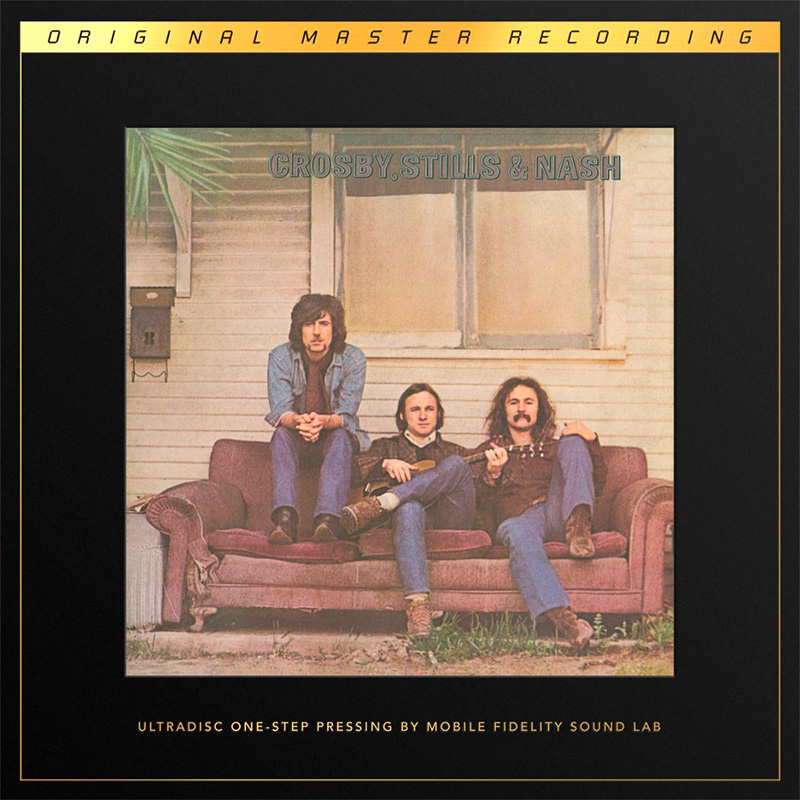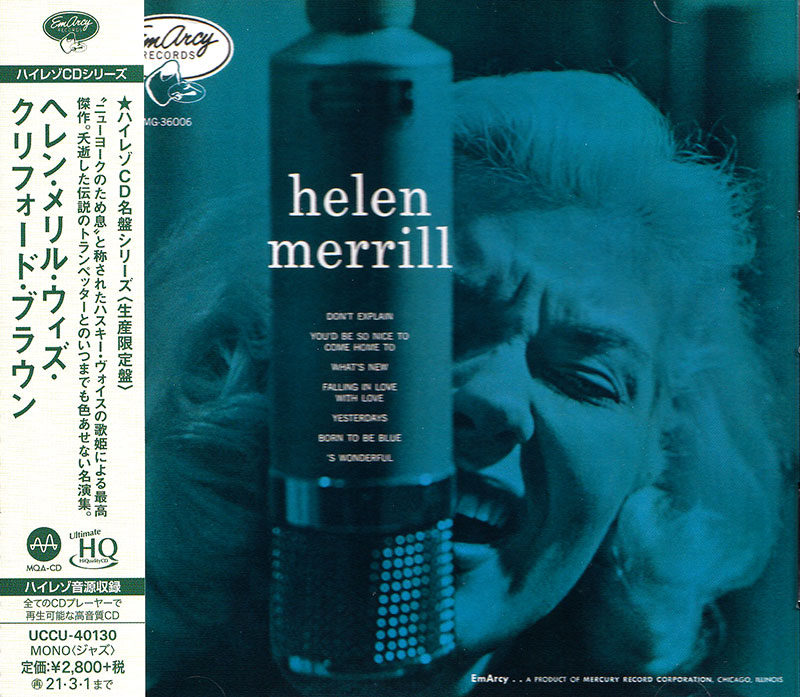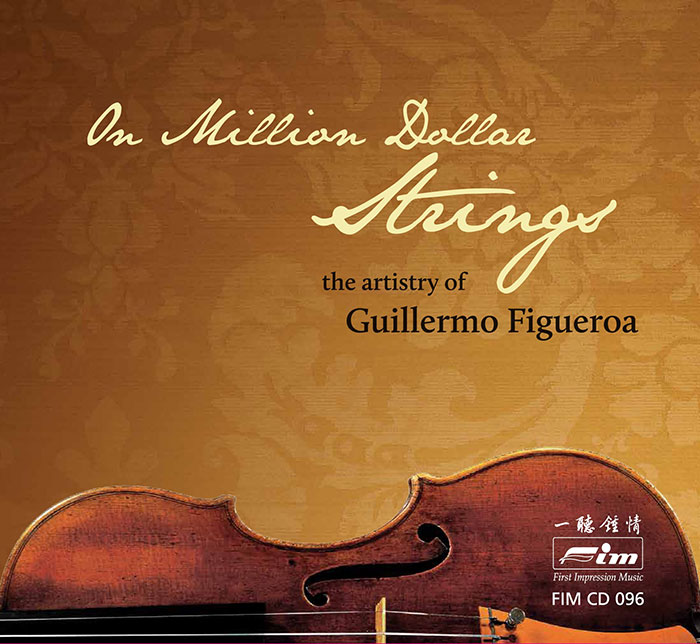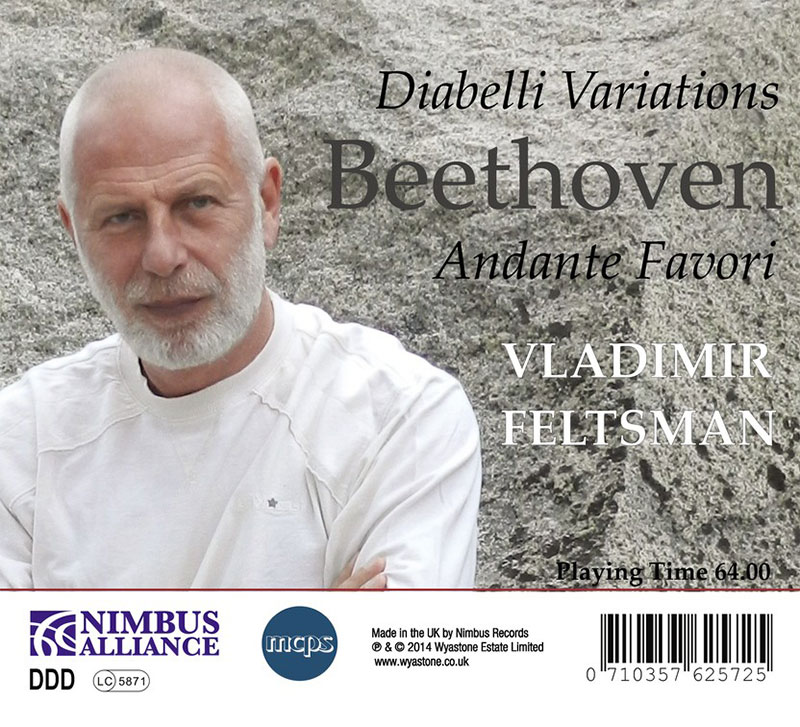Logowanie
OSTATNIE EGZEMPLARZE
Jakość LABORATORYJNA!
ORFF, Gundula Janowitz, Gerhard Stolze, Dietrich-Fischer Dieskau, Deutsche Oper Berlin, Eugen Jochum
Carmina Burana
ESOTERIC - NUMER JEDEN W ŚWIECIE AUDIOFILII I MELOMANÓW - SACD HYBR
Winylowy niezbędnik
ClearAudio
Essence MC
kumulacja zoptymalizowana: najlepsze z najważniejszych i najważniejsze z najlepszych cech przetworników Clearaudio
Direct-To-Disc
PIAZZOLLA, ChamberJam Europe
Tangos del Ángel y del Diablo
Direct-to-Disc ( D2D ) - Numbered Limited Edition
BEETHOVEN, Vladimir Feltsman
Diabelli Variations
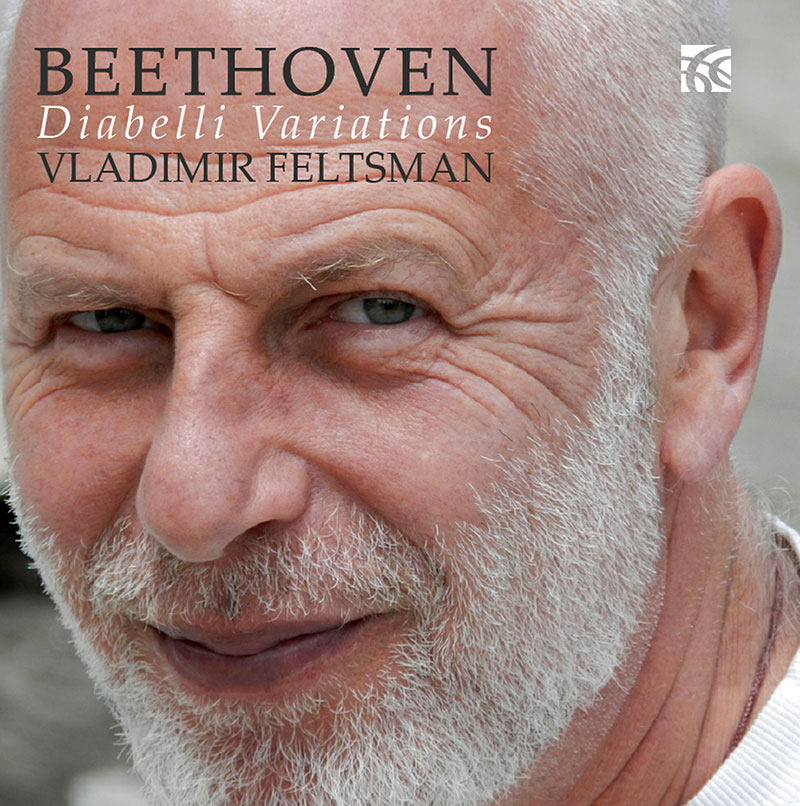
- Vladimir Feltsman - piano
- BEETHOVEN
![]() 3rd March 2014
“I found his playing involving and engaged. One aspect of his playing that caught my ear early on was the strength of his left hand. I can imagine that some listeners might even find some of the variations a little too bass-heavy though I liked the firmness and definition that Feltsman brings to the bass line”.
Vladimir Feltsman - w naszej ofercie
liner notes
THE DIABELLI VARIATIONS
Anton Diabelli, a Viennese publisher and composer of popular music for amateurs, published Beethoven's Thirty-Three Variations on a Waltz for Pianoforte in 1823. A year later he republished the set as Part I of a two-volume collection, Part II of which comprised 50 variations on the same “Given Theme”, each written by a different “prominent composer”. Among those who contributed were Hummel, Czerny, Kalkbrenner, Moscheles, Schubert, Archduke Rudolf and the 11-year-old Liszt. The “Given Theme” was a waltz, “Ein Deutsche” written by Diabelli himself.
According to his secretary, Schindler, Beethoven did not want to participate in this collective project and dismissed the Diabelli theme as a “cobbler’s patch” and a “rosalia”, but changed his mind when Diabelli offered him a handsome fee. It’s a good story but in fact Beethoven had started working on his variations before Diabelli conceived the idea of commissioning other composers to write variations on the same theme. By the end of 1819 Beethoven had already produced 19 variations. He then put this project aside until 1822 and completed the set in 1823.
Even judged by the highest standards of Beethoven’s output the Diabelli holds a very special place among his works. It is an opus magnum that summarizes not only Beethoven’s own experiments as a composer but those of the whole German musical tradition to which he considered himself a rightful heir. It is also among the wittiest of his compositions. The “cobbler’s patch” theme turned out to be a blessing, providing ideal material for Beethoven’s undertaking. “Rich and solid in musical facts from whatever point of view it is taken” and “cast in reinforced concrete”, in the words of Sir Donald Tovey, this simple theme gave Beethoven a time frame, a space to inhabit, a canvas to fill. Diabelli’s theme follows a simple harmonic structure—from tonic to dominant in the first half and from dominant to tonic in the second half. This theme is circular and closed within; the second half mirrors the first (a kitten chasing its tail). It is “Teifel music”, truly indestructible in its ordinariness, as German as beer and sausage, which do not have to be understood but simply enjoyed. The common vernacular is spoken here plainly; this “Deutsche” is not to be taken seriously. Beethoven took full advantage of this; humor, quotation, references to other composers and to himself abound in this work. Most of the variations could be considered parodies, which point to something beyond themselves.
Beethoven was the greatest engineer and master of musical time: each variation has its own time, different from that of the theme; the whole set could be described as a metamorphosis of time. It is a realization of Blake’s vision:
To see a World in a Grain of sand
And a Heaven in a Wild Flower,
Hold Infinity in the palm of your hand
And Eternity in an hour.
The idea of building an edifice of such magnitude, one of the two greatest variation cycles in music history (the first being Bach’s Goldberg Variations), on such a trifling theme might seem preposterous. However, it is not the subject of a set of variations that is important, but the craft and intentions of the composer who works with the “given” material. Diabelli’s “Deutsche” provided Beethoven with an excellent working model containing the basic elements that served as building blocks for his amazing construction. It provided him with firm ground and a point of departure.
Beethoven takes us for a ride, for a journey, but where? Every journey has a goal, a destination, and the Diabelli is no exception. After all is said and done, the goal turns out to be a homecoming. It takes 32 variations to achieve this goal, to return home to the Mozartean Tempo di Menuetto of the final variation and to reconcile and resolve everything that has gone before.
The journey starts with a surprise (one of many), a march! In the very first variation, Beethoven changes the three time signature of the waltz to four—a radical decision and a startling effect. Clearly it is not a real march, but a spoof. In the first draft of 1819, the present variation No. 3 came first, making for a more conventional beginning. Three years later, however, Beethoven wrote two new variations to open the set and another twelve that changed the whole design of the Diabelli and expanded its scope to encompass a humorous survey of music from the Baroque to himself.
The structure of the Diabelli is unique. It is a one-of-a-kind work with no precedent in Beethoven’s output or in music history. In his symphonies, sonatas and chamber music, Beethoven’s usual working method is development by variations. In the Diabelli this method is reversed to variations by development.
The variations fall into several distinct groups. The first ten are such a group and could be considered to constitute an exposition. The 10th variation Presto ends with the widest possible span from bass to treble, covering the whole keyboard in an explosive C major chord played ff.
The second group starts with the 11th variation, which is based on a simple and expressive motive (an opening turn given in triplets) that imitates itself ceaselessly in every bar in different voices. Contrapuntal imitation and increased harmonic complexity become more prominent as the Diabelli progresses. The 12th variation uses the same motive in inverted form: a witty and subtle inversion not easily recognized. The 13th variation enters with sudden exclamations, with a loud banging at the door: a syncopated rhythmic formula is given in chords forte (tutti), followed by silence and an echo response (soli). After this exchange is repeated twice, the echo grows bigger and louder and brings us back to the initial syncopated gesture. The 14th is the first slow variation of the set, Grave e maestoso. It repeats the syncopated rhythmic formula from the 13th, but very slowly, completely altering the meaning—instead of knocking at the door it becomes the signature formula for a stately funeral march in C major—one of the many subtle allusions with which the Diabelli is filled. The second group closes with Variation No. 20, one of the most mysterious and haunting of the set. Everything suddenly comes to a halt—time is out of joint. We are in terra incognita. A single line in the bass is answered in canon. A hushed sequence of chords follows, taking us through a maze of alien harmonic combinations. In the last four bars we are gradually finding firm ground and arrive at C major with the final chord.
The third group starts with the 21st variation, Allegro con brio, and we are back in action again; there are trilled jumps over the tonic and dominant down in the first half above sixteen repeated chords in the left hand and dominant and tonic jumps up in the second half under sixteen repeated chords in the right hand, making a total of 32, which is the number of bars in the Diabelli theme. There are two episodes marked Menno allegro—this is the first variation to include an internal change of tempo. Variation No. 22 contains a quotation from Mozart’s Don Giovanni. Beethoven uses Leporello’s aria Notte e giorno faticar (“To work night and day”) in which the Don’s servant complains that he has to work too hard. In this quotation Beethoven shows us the probable source of the Diabelli waltz—descending and ascending intervals of fourths and fifths, as well as of the theme in the second movement (Arietta) of Beethoven’s own sonata for piano Op. 111. Perhaps Beethoven sympathizes with Leporello’s complaint, and is hinting at his own long and hard work on the Diabelli Variations. The following 23rd variation is a parody of keyboard etudes and exercises in the manner of Cramer, Clementi and Czerny. (Beethoven was on good terms with all three). The 24th variation, Fughetta, one of three variations marked Andante, is in the idiom of J.S. Bach: there are four voices and the theme is properly inverted in the second half. All three Andante variations, 20, 24 and 30, are polyphonic and refer to Bach. In his late period, Beethoven’s understanding of and affinity to Bach were such that he did not have to “imitate” Bach, but simply wrote in an idiom that had become a natural language for him. The four virtuosic variations that follow the Fughetta explore a particular technical pattern—perpetual running turns in the left hand, arpeggios distributed between both hands, a sequence of accentuated chords. It seems that all the pianistic patterns and tricks of the trade have been exposed and explored; it is time to get away to something different.
The final group of the Diabelli is now at hand. It begins with three consecutive variations in C minor, followed by a triple fugue and a farewell minuet. The three C minor variations are written in the manner of Bach, the triple fugue is Handelian in style and the final minuet is Mozartean. No. 29, the first of the C minor variations, filled with sigh motives, is a twin of the first slow variation of the set, No. 14 Grave e maestoso in C major. The same syncopated figure is present in both variations, but the two are worlds apart in character: the 14th ends with an affirmative, assertive gesture and the 29th with melancholy surrender. Variation No. 30 is polyphonic, full of ascending imitations in the first half and sigh motives in the second half. The 31st variation, the longest in the set, is the emotional climax of the Diabelli. It is a requiem, a lament, a confessional meditation without any sentimentality. This variation is filled with rich ornamentation and fluttering ascending passages; the parallels with the 25th variation of the Goldberg Variations are unmistakable. (Beethoven had used such expressive richness of ornamentation before, for example in the Adagio of his Hammerklavier sonata Op. 106, which foreshadows the elaborate pianistic patterns of late Chopin and the voice leading of Brahms). The triple fugue of No. 32 follows, creating the expectation that it will be the finale, the crown of the set, but it is not. At the highest peak of accumulated energy the fugue suddenly stops on a diminished chord, goes wildly down and up twice all over the keyboard in an ecstatic outburst and freezes on a diminished chord again. One of the most magical and subtle transitions in Western music follows: we are brought back home to C major through two minimalistic shifts and enharmonic substitutions. The whole set of variations dissolves like a mirage in shimmering light and we find ourselves in the “promised land” of a Viennese minuet. The goal of the journey was always close at hand, but it took 32 variations and about an hour (a lifetime!) to discover. Tempo di Menuetto is Beethoven’s farewell to the Diabelli Variations, to the whole Viennese musical tradition, to the troubles and turmoil of life and to his own piano music. The last variation subtly traverses the course of the Arietta from Beethoven’s last piano sonata, No. 32 Op. 111. Indeed it’s hard not to see the 33rd variation as an extension of and post-scriptum to the sonata. The Diabelli ends unexpectedly and irreversibly without a bang, with a simple tonic chord.
The Andante favori was composed in 1803-4 as the second movement of the Waldstein sonata Op. 53. Told by a friend that the sonata had become too long, Beethoven took heed and replaced it with a much shorter introduction to the final movement, more fitting in the context of the sonata. The Andante favori was published in 1805 as a separate work. The title favori was coined by Czerny, because Beethoven played this lovely Andante often and it had become a favorite in Viennese musical circles.
3rd March 2014
“I found his playing involving and engaged. One aspect of his playing that caught my ear early on was the strength of his left hand. I can imagine that some listeners might even find some of the variations a little too bass-heavy though I liked the firmness and definition that Feltsman brings to the bass line”.
Vladimir Feltsman - w naszej ofercie
liner notes
THE DIABELLI VARIATIONS
Anton Diabelli, a Viennese publisher and composer of popular music for amateurs, published Beethoven's Thirty-Three Variations on a Waltz for Pianoforte in 1823. A year later he republished the set as Part I of a two-volume collection, Part II of which comprised 50 variations on the same “Given Theme”, each written by a different “prominent composer”. Among those who contributed were Hummel, Czerny, Kalkbrenner, Moscheles, Schubert, Archduke Rudolf and the 11-year-old Liszt. The “Given Theme” was a waltz, “Ein Deutsche” written by Diabelli himself.
According to his secretary, Schindler, Beethoven did not want to participate in this collective project and dismissed the Diabelli theme as a “cobbler’s patch” and a “rosalia”, but changed his mind when Diabelli offered him a handsome fee. It’s a good story but in fact Beethoven had started working on his variations before Diabelli conceived the idea of commissioning other composers to write variations on the same theme. By the end of 1819 Beethoven had already produced 19 variations. He then put this project aside until 1822 and completed the set in 1823.
Even judged by the highest standards of Beethoven’s output the Diabelli holds a very special place among his works. It is an opus magnum that summarizes not only Beethoven’s own experiments as a composer but those of the whole German musical tradition to which he considered himself a rightful heir. It is also among the wittiest of his compositions. The “cobbler’s patch” theme turned out to be a blessing, providing ideal material for Beethoven’s undertaking. “Rich and solid in musical facts from whatever point of view it is taken” and “cast in reinforced concrete”, in the words of Sir Donald Tovey, this simple theme gave Beethoven a time frame, a space to inhabit, a canvas to fill. Diabelli’s theme follows a simple harmonic structure—from tonic to dominant in the first half and from dominant to tonic in the second half. This theme is circular and closed within; the second half mirrors the first (a kitten chasing its tail). It is “Teifel music”, truly indestructible in its ordinariness, as German as beer and sausage, which do not have to be understood but simply enjoyed. The common vernacular is spoken here plainly; this “Deutsche” is not to be taken seriously. Beethoven took full advantage of this; humor, quotation, references to other composers and to himself abound in this work. Most of the variations could be considered parodies, which point to something beyond themselves.
Beethoven was the greatest engineer and master of musical time: each variation has its own time, different from that of the theme; the whole set could be described as a metamorphosis of time. It is a realization of Blake’s vision:
To see a World in a Grain of sand
And a Heaven in a Wild Flower,
Hold Infinity in the palm of your hand
And Eternity in an hour.
The idea of building an edifice of such magnitude, one of the two greatest variation cycles in music history (the first being Bach’s Goldberg Variations), on such a trifling theme might seem preposterous. However, it is not the subject of a set of variations that is important, but the craft and intentions of the composer who works with the “given” material. Diabelli’s “Deutsche” provided Beethoven with an excellent working model containing the basic elements that served as building blocks for his amazing construction. It provided him with firm ground and a point of departure.
Beethoven takes us for a ride, for a journey, but where? Every journey has a goal, a destination, and the Diabelli is no exception. After all is said and done, the goal turns out to be a homecoming. It takes 32 variations to achieve this goal, to return home to the Mozartean Tempo di Menuetto of the final variation and to reconcile and resolve everything that has gone before.
The journey starts with a surprise (one of many), a march! In the very first variation, Beethoven changes the three time signature of the waltz to four—a radical decision and a startling effect. Clearly it is not a real march, but a spoof. In the first draft of 1819, the present variation No. 3 came first, making for a more conventional beginning. Three years later, however, Beethoven wrote two new variations to open the set and another twelve that changed the whole design of the Diabelli and expanded its scope to encompass a humorous survey of music from the Baroque to himself.
The structure of the Diabelli is unique. It is a one-of-a-kind work with no precedent in Beethoven’s output or in music history. In his symphonies, sonatas and chamber music, Beethoven’s usual working method is development by variations. In the Diabelli this method is reversed to variations by development.
The variations fall into several distinct groups. The first ten are such a group and could be considered to constitute an exposition. The 10th variation Presto ends with the widest possible span from bass to treble, covering the whole keyboard in an explosive C major chord played ff.
The second group starts with the 11th variation, which is based on a simple and expressive motive (an opening turn given in triplets) that imitates itself ceaselessly in every bar in different voices. Contrapuntal imitation and increased harmonic complexity become more prominent as the Diabelli progresses. The 12th variation uses the same motive in inverted form: a witty and subtle inversion not easily recognized. The 13th variation enters with sudden exclamations, with a loud banging at the door: a syncopated rhythmic formula is given in chords forte (tutti), followed by silence and an echo response (soli). After this exchange is repeated twice, the echo grows bigger and louder and brings us back to the initial syncopated gesture. The 14th is the first slow variation of the set, Grave e maestoso. It repeats the syncopated rhythmic formula from the 13th, but very slowly, completely altering the meaning—instead of knocking at the door it becomes the signature formula for a stately funeral march in C major—one of the many subtle allusions with which the Diabelli is filled. The second group closes with Variation No. 20, one of the most mysterious and haunting of the set. Everything suddenly comes to a halt—time is out of joint. We are in terra incognita. A single line in the bass is answered in canon. A hushed sequence of chords follows, taking us through a maze of alien harmonic combinations. In the last four bars we are gradually finding firm ground and arrive at C major with the final chord.
The third group starts with the 21st variation, Allegro con brio, and we are back in action again; there are trilled jumps over the tonic and dominant down in the first half above sixteen repeated chords in the left hand and dominant and tonic jumps up in the second half under sixteen repeated chords in the right hand, making a total of 32, which is the number of bars in the Diabelli theme. There are two episodes marked Menno allegro—this is the first variation to include an internal change of tempo. Variation No. 22 contains a quotation from Mozart’s Don Giovanni. Beethoven uses Leporello’s aria Notte e giorno faticar (“To work night and day”) in which the Don’s servant complains that he has to work too hard. In this quotation Beethoven shows us the probable source of the Diabelli waltz—descending and ascending intervals of fourths and fifths, as well as of the theme in the second movement (Arietta) of Beethoven’s own sonata for piano Op. 111. Perhaps Beethoven sympathizes with Leporello’s complaint, and is hinting at his own long and hard work on the Diabelli Variations. The following 23rd variation is a parody of keyboard etudes and exercises in the manner of Cramer, Clementi and Czerny. (Beethoven was on good terms with all three). The 24th variation, Fughetta, one of three variations marked Andante, is in the idiom of J.S. Bach: there are four voices and the theme is properly inverted in the second half. All three Andante variations, 20, 24 and 30, are polyphonic and refer to Bach. In his late period, Beethoven’s understanding of and affinity to Bach were such that he did not have to “imitate” Bach, but simply wrote in an idiom that had become a natural language for him. The four virtuosic variations that follow the Fughetta explore a particular technical pattern—perpetual running turns in the left hand, arpeggios distributed between both hands, a sequence of accentuated chords. It seems that all the pianistic patterns and tricks of the trade have been exposed and explored; it is time to get away to something different.
The final group of the Diabelli is now at hand. It begins with three consecutive variations in C minor, followed by a triple fugue and a farewell minuet. The three C minor variations are written in the manner of Bach, the triple fugue is Handelian in style and the final minuet is Mozartean. No. 29, the first of the C minor variations, filled with sigh motives, is a twin of the first slow variation of the set, No. 14 Grave e maestoso in C major. The same syncopated figure is present in both variations, but the two are worlds apart in character: the 14th ends with an affirmative, assertive gesture and the 29th with melancholy surrender. Variation No. 30 is polyphonic, full of ascending imitations in the first half and sigh motives in the second half. The 31st variation, the longest in the set, is the emotional climax of the Diabelli. It is a requiem, a lament, a confessional meditation without any sentimentality. This variation is filled with rich ornamentation and fluttering ascending passages; the parallels with the 25th variation of the Goldberg Variations are unmistakable. (Beethoven had used such expressive richness of ornamentation before, for example in the Adagio of his Hammerklavier sonata Op. 106, which foreshadows the elaborate pianistic patterns of late Chopin and the voice leading of Brahms). The triple fugue of No. 32 follows, creating the expectation that it will be the finale, the crown of the set, but it is not. At the highest peak of accumulated energy the fugue suddenly stops on a diminished chord, goes wildly down and up twice all over the keyboard in an ecstatic outburst and freezes on a diminished chord again. One of the most magical and subtle transitions in Western music follows: we are brought back home to C major through two minimalistic shifts and enharmonic substitutions. The whole set of variations dissolves like a mirage in shimmering light and we find ourselves in the “promised land” of a Viennese minuet. The goal of the journey was always close at hand, but it took 32 variations and about an hour (a lifetime!) to discover. Tempo di Menuetto is Beethoven’s farewell to the Diabelli Variations, to the whole Viennese musical tradition, to the troubles and turmoil of life and to his own piano music. The last variation subtly traverses the course of the Arietta from Beethoven’s last piano sonata, No. 32 Op. 111. Indeed it’s hard not to see the 33rd variation as an extension of and post-scriptum to the sonata. The Diabelli ends unexpectedly and irreversibly without a bang, with a simple tonic chord.
The Andante favori was composed in 1803-4 as the second movement of the Waldstein sonata Op. 53. Told by a friend that the sonata had become too long, Beethoven took heed and replaced it with a much shorter introduction to the final movement, more fitting in the context of the sonata. The Andante favori was published in 1805 as a separate work. The title favori was coined by Czerny, because Beethoven played this lovely Andante often and it had become a favorite in Viennese musical circles.

